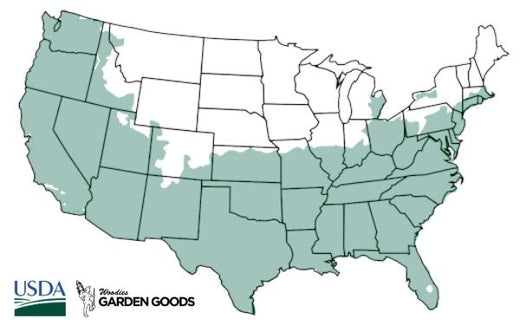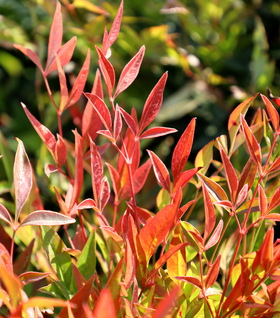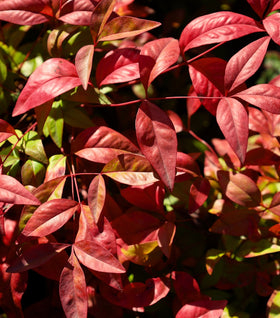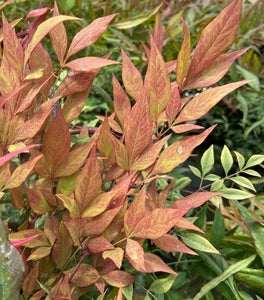Images Depict Mature Plants
Harbour Dwarf Nandina for Sale Online
Harbour Dwarf Nandina is an attractive compact evergreen shrub that displays brilliant bronze-red foliage in fall and winter. Most effective when used as a ground cover, specimen plant, or border. Soft green foliage has a pink tint in spring. This shrub will only grow about 18 inches tall and spread up to 3 feet wide. Harbour Dwarf Nandina shrubs are clump-forming and provide a soft texture in the landscape when used in small groupings or mass plantings as a groundcover. Because Nandinas are known for spreading, we recommend that you plant them 18 inches apart for mass plantings and 4 feet or more apart from other plants.
| Hardiness Zone: | 6-11 |
|---|---|
| Mature Height: | 1 to 1.5 feet |
| Mature width: | 2 to 2.5 feet |
| Classification: | Dwarf, Compact,Broad leaved evergreen shrub |
| Sunlight: | Full Sun to Part Shade |
| Habit: | small ground cover shrub |
| Foliage: | Soft green turning bronze red in fall |
| Flower Color: | White |
| Pruning Season: | Pruning not needed |
| Soil Condition: | Any well drained soil |
| Water Requirement: | Water well until established. |
| Uses: | Extremely attractive when used as in the mixed border, or containers. |

How to Care for Harbour Dwarf Nandina
Before you purchase a Harbour Dwarf Nandina, be sure to read the recommended care instructions to ensure your plant remains happy and thriving for many years to come!
How Do I Plant My Harbour Dwarf Nandina?
When planting your newly purchased Harbour Dwarf Nandina plant, dig a hole twice as wide as the root system but not deeper. Depending on the quality of your existing soil, you may need to add locally sourced compost or topsoil to the back-fill soil. We do not recommend using straight topsoil or compost as a back-fill soil because more times than not, these products will retain entirely too much moisture and will cause the root system to rot. Adding compost or topsoil will help the young feeder roots of Harbour Dwarf Nandina to spread through the loose, nutrient-rich soil, much easier than if you used solely the existing soil, which more times than not will be hard and compacted. The most common cause of plant death after transplanting is planting the new plant too deep. A good rule is that you should still see the soil the plant was grown in after back-filling the hole. Bio-tone starter fertilizer is a starter fertilizer that provides plants with a mycorrhizal fungus. It is a naturally occurring beneficial fungus that colonizes the new growing roots of plants. It creates a barrier between the roots and fungus and pathogens that can cause root rot.
How Often Should I Water My Harbour Dwarf Nandina?
After backfilling and lightly compacting the 50/50 mix of existing soil and compost, give the Harbour Dwarf Nandina a deep watering. Most of the water you put on the plant at first will run away from the plant until the soil is soaked. A general rule of thumb is to count to 5 for every one gallon of pot size. For example, a one-gallon pot should be watered until you count to 5, and a three-gallon container would be 15, and so on. Check the plant daily for the first week or so and then every other day. Water your shrubs using the counting method for the first few weeks. Soaker Hoses can also be used to water when planting a long hedge.
What Kind of Fertilizer Should I Use for my Harbour Dwarf Nandina?
Harbour Dwarf Nandina grows best if they are fertilized once in the spring and again in early summer. Harbour Dwarf Nandina favors nutrient-rich soil and ample fertilization; that is why we recommend an Organic fertilizer that tends to release nutrients over a long period. Either chemical fertilizers or organic matter can be successful. Since an organic method of applying manure and compost around the roots produces excellent results and improves the condition of the soil, this would be an excellent first line of attack. If chemical fertilizers are used on your Harbour Dwarf Nandina, applying a slow-release, balanced fertilizer once a year in the spring is probably the simplest solution. Don’t fertilize Harbour Dwarf Nandina after August In the North. Fall is the time for nandinas to begin preparing for dormancy. Fertilizing at this time may stimulate new growth that will be too tender to withstand the winter. In the South, late summer into September, an application would be about right.
How Do Mulch My Harbour Dwarf Nandina?
We highly recommend that you mulch your Harbour Dwarf Nandina with either a ground hardwood mulch or a ground cypress mulch depending on your local availability. Any mulch will do, but cypress or hardwood mulch will be of a higher quality and provide better nutrition overall as they break down. Mulching helps to keep weeds away, which will compete with your new investment in water and nutrients. A 2 to 3-inch layer of mulch is sufficient but remember to take care not to cover any part of the stem with mulch. It is better to leave a one-inch gap of space between the mulch and the stem or trunk of the plant.









